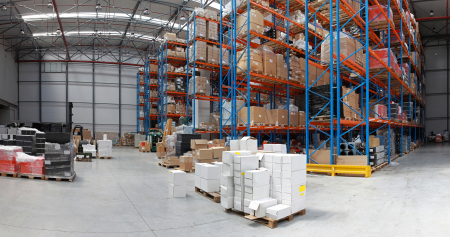You can achieve improved productivity in your distribution business’ warehouse through a variety of activities, ranging from automating order entry processes to providing training for staff. By definition, productivity describes the input to output ratio on a final product, so warehouse oriented businesses are always looking for ways to better manage those inputs while still producing quality outputs. With the help of distribution software, here are three ways this can be done:
1. Optimize picking/packing processes
As a distribution business, it is very important to optimize the basic picking and packing processes in your warehouse. Saving time and reducing errors here presents a huge opportunity to increase productivity. Consider investing in distribution ERP software with barcode scanning functionality to streamline the receiving, picking, packing, and shipping process. A great alternative to a heavy, expensive, traditional barcode scanning machine is a mobile application that runs on iOS devices. This technology streamlines many processes in the warehouse including the ability to itemize products that need to be picked, mapping out how employees should go through the warehouse most efficiently. Pickers and packers can also quickly scan and look up inventory items at the source to retrieve information about the product such as descriptions, pricing and images and in the case of an empty shelf if the item is somewhere in overstock, on backorder or available at other locations. Using this kind of mobile barcode scanning application for handheld picking and receiving is a great alternative to traditional scanners, and will help eliminate the errors and time constraints of performing these tasks manually with pen and paper.
2. Tightly integrate your distribution ERP system with shipping software
Large shipping companies such as FedEx, UPS, or Canada Post have their own shipping software which customers must have an account with to create shipments. When looking for a system to manage your inventory, as well as order entry and processing (including shipping!), be sure to choose one that can integrate with these large companies. Your ERP system should be able to push and pull information from your account with FedEx or UPS to save you from having to enter shipments twice into two separate software screens.
Aside from the time savings of being able to use just one system, integration between your ERP system and a shipping provider can save your company dollars as well. For example, with Canada Post, the options for insurance on the shipment, or requesting a signature on delivery come at an additional cost to your company. Right now, you may have some rules in place to ensure that employees are un-checking or checking boxes correctly for when you need or don’t need the insurance or signature. With tight integration between your ERP system and Canada Post, these items can be automated. For example, you can set it up so insurance is only used for orders over $200, or signatures are only needed for orders over $50. Although a simple automation, it eliminates the possibility for human error and discretion, and these seemingly small savings can add up quickly as order volume increases!
3. Manage inventory from one central system
A final way to improve productivity in your warehouse is to implement methods and software that allow for one central database. This is very important for any distributor, especially if you are operating in the world of eCommerce and managing multiple sales channels. Customers purchasing product online expect inventory levels to match what the company has in stock - with the increase in competition today, customers are no longer willing to wait long periods of time for their purchases to arrive. To avoid this, ensure that your inventory management ERP system is tightly integrated with your eCommerce website, and maintain your ERP system as the central point of information. This means all data is entered and modified in one system and the integration allows information from your ERP to automatically populate online, and vice versa. Integration can further be set up so customers are automatically notified when orders are shipped and are able to track their shipments. By keeping all inventory information in one central system, companies don’t need to worry about selling product they don’t have, or misinformation being displayed online for their customers.
Improving productivity in your warehouse will help your company reduce errors, and will open up the doors to automate a number of activities. One of the biggest benefits your company will see by implementing the ideas mentioned above is less time spent on each order. It may not be a whole lot of time, but even if you are saving 15-20 seconds per order, it can add up quickly when dealing with 500-1000 orders per day. As a distributer, that is your business – sending out as many orders as possible, as quickly as possible. When you take steps to reduce time per order, it opens up the door to service more customers in the same day.










